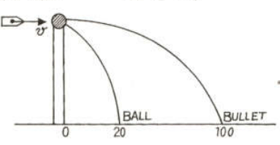An athlete in the Olympic Games covers a distance of in . His kinetic energy can be estimated to be in the range

Important Questions on Work, Power and Energy
A shell explodes in mid-air. It's total:
A body is moving at a speed of . A force is required to stop it within a distance . If the speed of the body increases to , then the force required to stop it within the same distance will be:
The relation between the displacement and the time for a body of mass moving under the action of a force is given by , where is in metre and in second. The work done (in joule) by the body in the first two seconds is:
A ball of mass is thrown vertically upward by applying a force by hand. If the hand moves while applying the force and the ball goes up to height further, find the magnitude of the force. Consider .
A particle is free to move along the -axis has potential energy given by for , where is a positive constant of appropriate dimensions. Then:
When a spring is stretched through a distance , its potential energy is . The work (in joule) required to stretch it further through will be:
Two springs of force-constants and are stretched by the same force. The ratio of potential energies stored in them is:
A ball of mass rests on a vertical post of height . A bullet of mass , travelling with velocity in a horizontal direction, hits the centre of the ball. After the collision, the ball and bullet travel independently. The ball hits the ground at a distance of and the bullet at a distance of from the foot of the post. The initial velocity of the bullet is:

